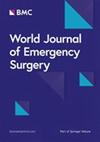Diagnostic accuracy of routine hematological biomarkers for complications and prognosis in bowel obstruction: a systematic review and meta-analysis.
IF 5.8
1区 医学
Q1 EMERGENCY MEDICINE
引用次数: 0
Abstract
BACKGROUND Bowel obstruction is a critical emergency. Although imaging like X-ray and computed tomography (CT) aids diagnosis, cost-effective hematological biomarkers are still needed. This study evaluates the diagnostic values of hematological biomarkers for detecting complications, determining the need for surgery, and predicting prognosis in patients with bowel obstruction. METHODS A systematic review and meta-analysis was conducted following PRISMA guidelines. We systematically searched Web of Science, PubMed, Scopus, Embase and Cochrane Library for studies published up to June 2025. Inclusion criteria encompassed observational or case-control studies reporting sensitivity/specificity of neutrophil-lymphocyte ratio (NLR), C-reactive protein (CRP), procalcitonin (PCT), D-dimer, or lactate in bowel obstruction outcomes. Data extraction included true/false, positives/negatives, cutoff values, and receiver operating characteristic (ROC) parameters. Bivariate models pooled sensitivity/specificity, while summary ROC curves and Youden index determined optimal thresholds. RESULTS This study included 34 articles comprising a total of 5871 patients. CRP at a cutoff of 26.91 mg/L (Youden index: 0.97) for diagnosing bowel ischemia showed pooled sensitivity and specificity of 0.80 and 0.92, respectively, with a summary receiver operating characteristic (SROC) curve and an area under the curve (AUC) of 0.91. PCT in determining the need for surgery achieved a cutoff of 0.12 ng/mL (Youden index: 0.8), with sensitivity and specificity of 0.75 and 0.74 (AUC: 0.79). NLR showed a cutoff of 7.2 (Youden index: 0.68), yielding sensitivity and specificity of 0.74 and 0.83 (AUC: 0.84) in the diagnosis of bowel ischemia. D-dimer (cutoff: 1.72 mg/L, Youden index: 0.91) and lactate (cutoff: 2.98 mmol/L, Youden index: 0.8) exhibited sensitivities of 0.83 and 0.77, specificities of 0.70 and 0.79, and AUCs of 0.85 for both, in the diagnosis of bowel ischemia. CONCLUSION NLR, CRP, PCT, D-dimer, and lactate may provide supplementary diagnostic value for bowel ischemia in patients with bowel obstruction. A PCT threshold > 0.12 ng/mL may assist in evaluating the need for surgery.常规血液学生物标志物对肠梗阻并发症和预后的诊断准确性:系统回顾和荟萃分析。
背景:肠梗阻是一种严重的急症。尽管像x射线和计算机断层扫描(CT)这样的成像有助于诊断,但仍然需要具有成本效益的血液学生物标志物。本研究评估血液学生物标志物在肠梗阻患者中检测并发症、确定手术需要和预测预后方面的诊断价值。方法按照PRISMA指南进行系统评价和荟萃分析。我们系统地检索了Web of Science、PubMed、Scopus、Embase和Cochrane Library,检索了截至2025年6月发表的研究。纳入标准包括观察性或病例对照研究,报告了中性粒细胞-淋巴细胞比率(NLR)、c反应蛋白(CRP)、降钙素原(PCT)、d -二聚体或乳酸盐在肠梗阻结果中的敏感性/特异性。数据提取包括真/假、阳性/阴性、截止值和受试者工作特征(ROC)参数。双变量模型汇集敏感性/特异性,而汇总ROC曲线和约登指数确定最佳阈值。结果纳入34篇文献,共5871例患者。CRP诊断肠缺血的临界值为26.91 mg/L(约登指数为0.97),其敏感性和特异性分别为0.80和0.92,总受试者工作特征曲线(SROC)和曲线下面积(AUC)分别为0.91。PCT在确定是否需要手术方面的截止值为0.12 ng/mL(约登指数:0.8),敏感性和特异性分别为0.75和0.74 (AUC: 0.79)。NLR的临界值为7.2(约登指数为0.68),诊断肠缺血的敏感性和特异性分别为0.74和0.83 (AUC为0.84)。d -二聚体(临界值:1.72 mg/L,约登指数:0.91)和乳酸(临界值:2.98 mmol/L,约登指数:0.8)诊断肠缺血的敏感性分别为0.83和0.77,特异性分别为0.70和0.79,auc均为0.85。结论nlr、CRP、PCT、d -二聚体、乳酸对肠梗阻患者肠缺血有补充诊断价值。PCT阈值> 0.12 ng/mL可能有助于评估是否需要手术。
本文章由计算机程序翻译,如有差异,请以英文原文为准。
求助全文
约1分钟内获得全文
求助全文
来源期刊

World Journal of Emergency Surgery
EMERGENCY MEDICINE-SURGERY
CiteScore
14.50
自引率
5.00%
发文量
60
审稿时长
10 weeks
期刊介绍:
The World Journal of Emergency Surgery is an open access, peer-reviewed journal covering all facets of clinical and basic research in traumatic and non-traumatic emergency surgery and related fields. Topics include emergency surgery, acute care surgery, trauma surgery, intensive care, trauma management, and resuscitation, among others.
 求助内容:
求助内容: 应助结果提醒方式:
应助结果提醒方式:


